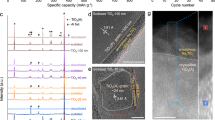Abstract
Microcrystalline TiO2 with an anatase crystal structure is used as an anode material for lithium rechargeable batteries1,2, and also as a material for electrochromic3,4,5,6 and solar-cell devices7,8. When intercalated with lithium, as required for battery applications, TiO2 anatase undergoes spontaneous phase separation into lithium-poor (Li0.01TiO2) and lithium-rich (Li0.6TiO2) domains on a scale of several tens of nanometres9. During discharge, batteries need to maintain a constant electrical potential between their electrodes over a range of lithium concentrations. The two-phase equilibrium system in the electrodes provides such a plateau in potential, as only the relative phase fractions vary on charging (or discharging) of the lithium. Just as the equilibrium between a liquid and a vapour is maintained by a continuous exchange of particles between the two phases, a similar exchange is required to maintain equilibrium in the solid state. But the time and length scales over which this exchange takes place are unclear. Here we report the direct observation by solid-state nuclear magnetic resonance of the continuous lithium-ion exchange between the intermixed crystallographic phases of lithium-intercalated TiO2. We find that, at room temperature, the continuous flux of lithium ions across the phase boundaries is as high as 1.2 × 1020 s-1 m-2.



Similar content being viewed by others
References
Huang, S. Y., Kavan, L., Exnar, I. & Grätzel, M. J. Rocking chair lithium battery based on nanocrystalline TiO2 (anatase). J. Electrochem. Soc. 142, L142–L144 (1995)
Ohzuku, T., Kodama, T. & Hirai, T. Electrochemistry of anatase titanium dioxide in lithium non-aqueous cells. J. Power Sources 14, 153–166 (1985)
Ohzuku, T. & Hirai, T. An electrochromic display based on titanium dioxide. Electrochim. Acta 27, 1263–1266 (1982)
Ottaviani, M., Panero, S., Morzilli, S. & Scrosati, B. The electrochromic characteristics of titanium oxide thin film electrodes. Solid State Ionics 20, 197–202 (1986)
Cantao, M. P., Cisneros, J. I. & Torresi, R. M. Electrochromic behaviour of sputtered titanium-oxide thin-films. Thin Solid Films 259, 70–74 (1995)
Bechinger, C., Ferrere, S., Zaban, A., Sprague, J. & Gregg, B. A. Photoelectrochromic windows and displays. Nature 383, 608–610 (1996)
O'Regan, B. & Grätzel, M. A low-cost, high-efficiency solar-cell based on dye-sensitised colloidal TiO2 films. Nature 353, 737–740 (1991)
Hagfeldt, A. & Grätzel, M. Light-induced redox reactions in nanocrystalline systems. Chem. Rev. 95, 49–68 (1995)
Wagemaker, M., van de Krol, R., Kentgens, A. P. M., van Well, A. A. & Mulder, F. M. Two phase morphology limits lithium diffusion in TiO2 (anatase): A Li-7 MAS NMR study. J. Am. Chem. Soc. 46, 11454–11461 (2001)
Xu, Z. & Stebbins, J. F. Cation dynamics and diffusion in lithium orthosilicate — 2-dimensional Li-6 NMR. Science 270, 1332–1334 (1995)
Verhoeven, V. W. J. et al. Lithium dynamics in LiMn2O4 probed directly by two-dimensional Li-7 NMR. Phys. Rev. Lett. 86, 4314–4317 (2001)
Ernst, R. R., Bodenhausen, G. & Wokaun, A. Principles of Nuclear Magnetic Resonance in One and Two Dimensions (Clarendon, Oxford, 1994)
Lunell, S., Stashans, A., Ojamae, L., Lindstrom, H. & Hagfeldt, A. Li and Na diffusion in TiO2 from quantum chemical theory versus electrochemical experiment. J. Am. Chem. Soc. 119, 7374–7380 (1997)
Kavan, L., Grätzel, M., Gilbert, S. E., Klemenz, C. & Schell, H. J. Electrochemical and photoelectrochemical investigation of single-crystal anatase. J. Am. Chem. Soc. 118, 6716–6723 (1996)
Claus, J., Schmidt-Rohr, K. & Spiess, H. W. Determination of domain sizes in heterogeneous polymers by solid-state NMR. Acta Polym. 44, 1–17 (1993)
Schmidt-Rohr, K. & Spiess, H. W. Multidimensional Solid-state NMR and Polymers (Academic, London, 1994)
Koudriachova, M. V., Harrison, N. M. & de Leeuw, S. W. Effect of diffusion on lithium intercalation in titanium dioxide. Phys. Rev. Lett. 86, 1275–1278 (2001)
Acknowledgements
This work is a contribution from the Delft Institute for Sustainable Energy (DISE).
Author information
Authors and Affiliations
Corresponding author
Ethics declarations
Competing interests
The authors declare that they have no competing financial interests.
Rights and permissions
About this article
Cite this article
Wagemaker, M., Kentgens, A. & Mulder, F. Equilibrium lithium transport between nanocrystalline phases in intercalated TiO2 anatase. Nature 418, 397–399 (2002). https://doi.org/10.1038/nature00901
Received:
Accepted:
Issue Date:
DOI: https://doi.org/10.1038/nature00901
- Springer Nature Limited
This article is cited by
-
Melamine-templated TiO2 nanoparticles as anode with high capacity and cycling stability for lithium-ion batteries
Journal of Solid State Electrochemistry (2021)
-
Design strategies for nonaqueous multivalent-ion and monovalent-ion battery anodes
Nature Reviews Materials (2020)
-
Microscopic photoelectron analysis of single crystalline LiCoO2 particles during the charge-discharge in an all solid-state lithium ion battery
Scientific Reports (2019)
-
Robust electrochemistry of black TiO2 as stable and high-rate negative electrode for lithium-ion batteries
Materials for Renewable and Sustainable Energy (2019)
-
An overview of engineered porous material for energy applications: a mini-review
Ionics (2018)





